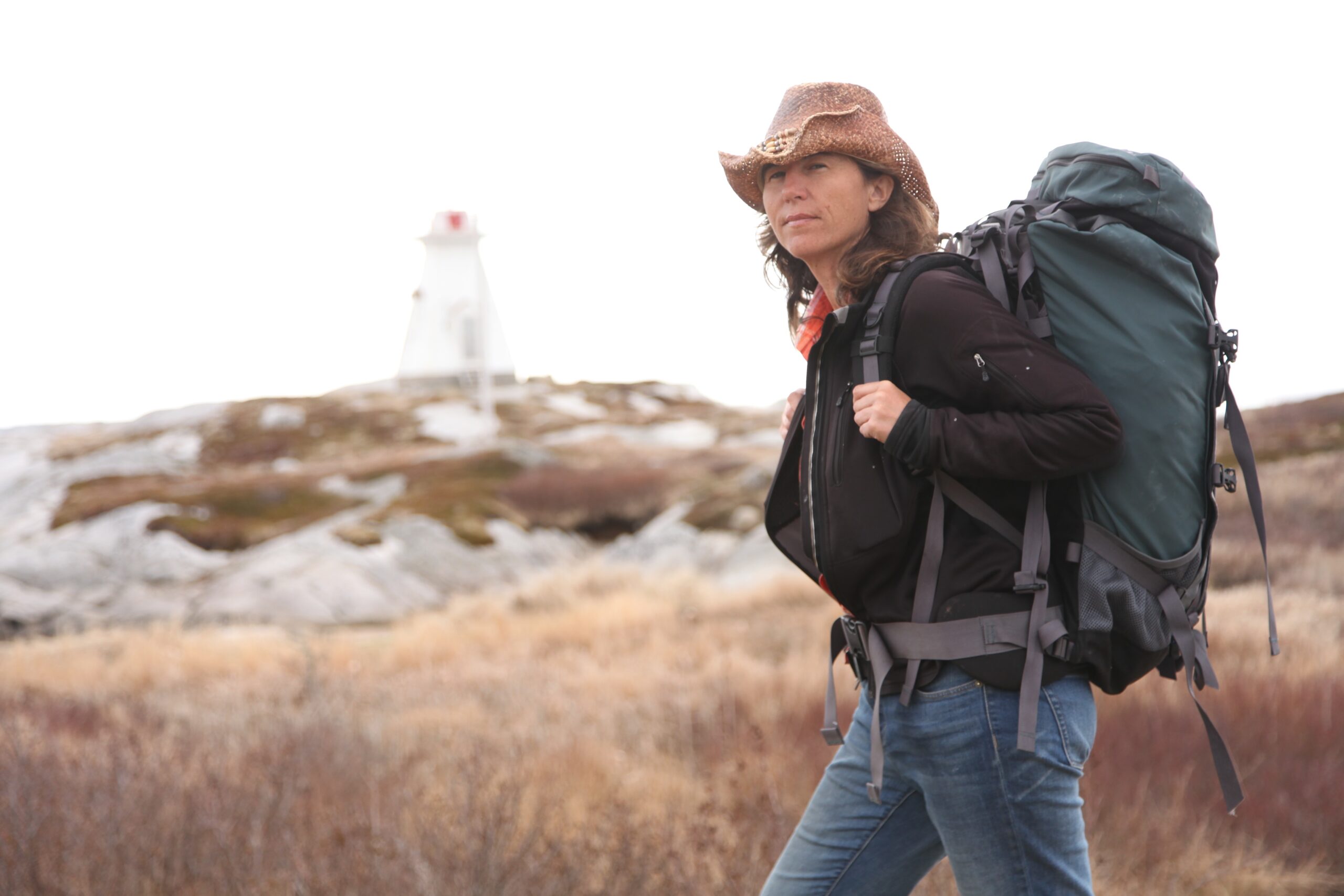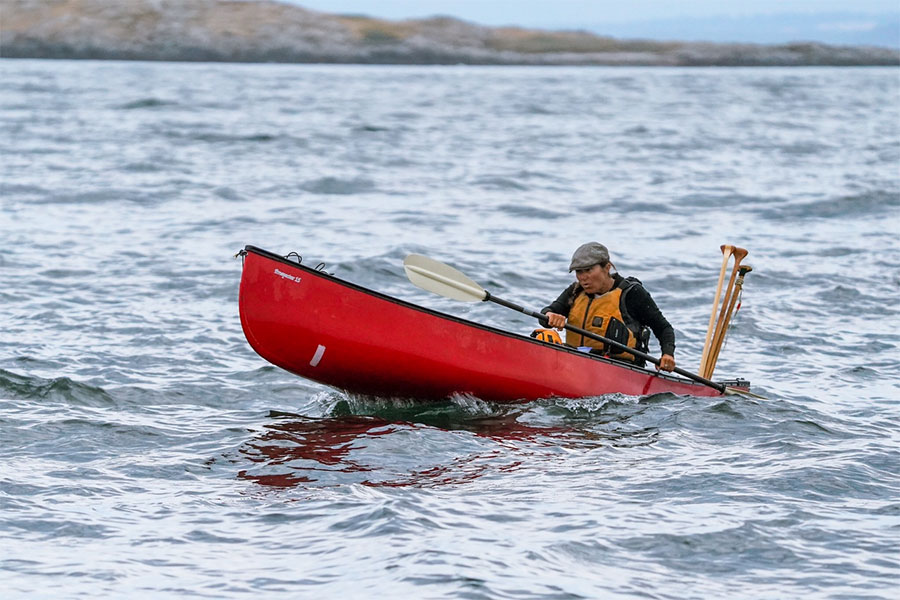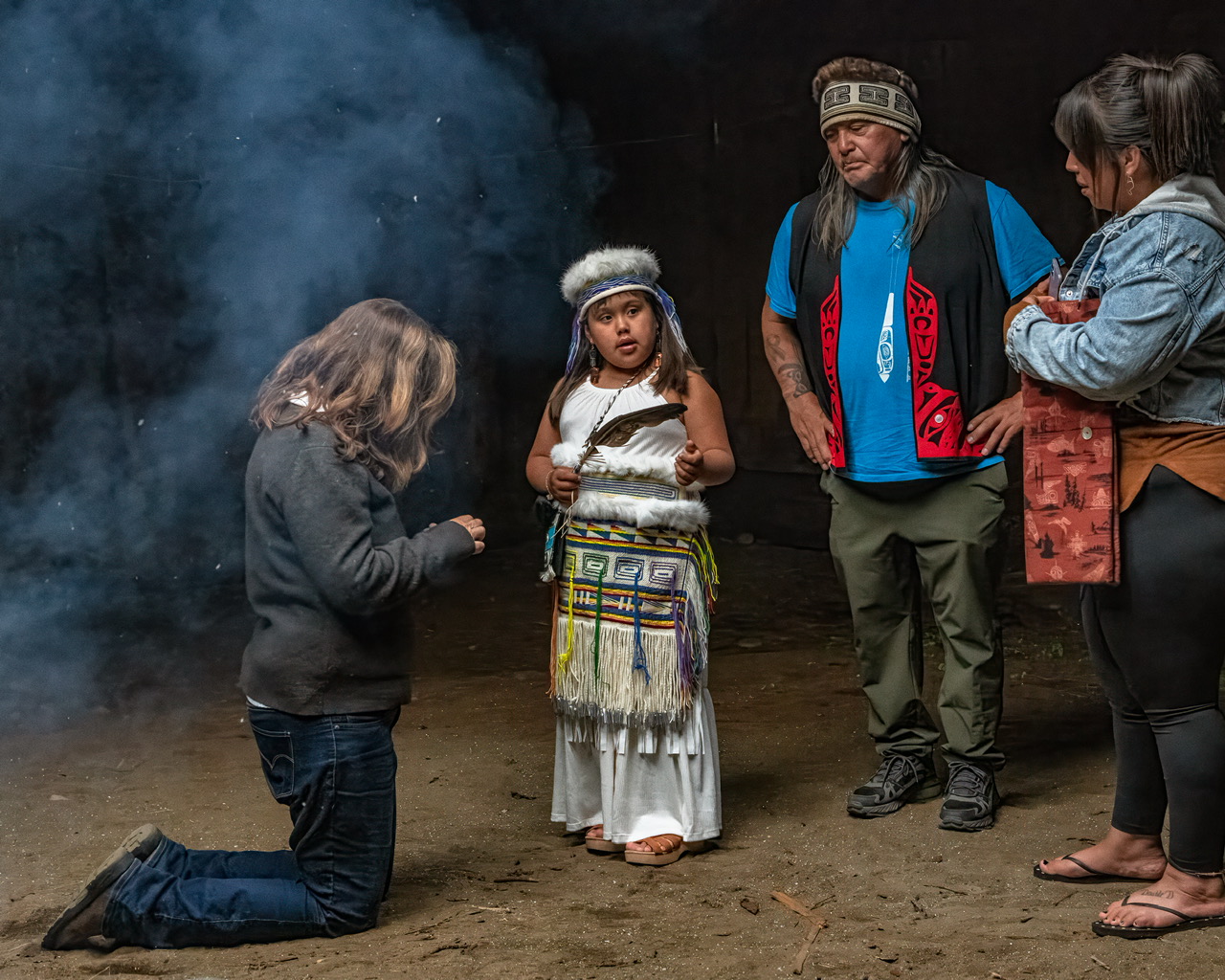‘500 Days In The Wild’ Filmmaker Dianne Whelan Talks Traversing the Entire Trans Canada Trail at 50

Dianne Whelan on the Trans Canada Trail in Cape Breton, Nova Scotia. In 2015, at age 50, she set out to become the first person to complete the entire trail, which at that point ran for 24,000 km (and is now 28,000 km). Photo: Rob Smith
Dianne Whelan was feeling lost. Her marriage had ended and she “wanted to be in nature,” and needed a new film project, to boot. After directing This Land, in which she was the only woman on a 16-day 2000-kilometre expedition across the Arctic (published as a book, too, called This Vanishing Land: A Woman’s Journey to the Canadian Arctic ) in 2007, and a following three Mount Everest climbing teams for her film 40 Days at Base Camp (also a book) a few years later, the 50-year-old turned the lens on someone she knew intimately: herself.
In July 2015, she “chose” to hike, bike, canoe, snowshoe, and cross-country ski the entire length of 24,000 k.m. Trans Canada Trail (now 28,000 k.m.). She thought it would take 500 days; it took six years. Along the way, she saw the breathtaking beauty of this country, got up close and personal with horses, frogs, foxes, birds, moose, flies – kept bears at bay – and endured the most extreme weather conditions from torrential rain to a flash-frozen lake.
The Emmy Award-winning filmmaker was helped at points along the way by friends, relatives, partner, and strangers. She is the first person to complete the whole trail, starting at “mile zero” in St. John’s, Newfoundland, and ending at Clover Point in British Columbia.
Now, at 59, Whelan tells Zoomer she had 800 hours of footage and five editors to help distill her journey down to the two hour film 500 Days In The Wild, which won the Audience Award at the Whistler Film Festival in December and is now streaming on Paramount+.
“It’s a very personal story and I felt very vulnerable. But, right from the opening [of the film] at Whistler, onwards – this film’s only 15, 16 weeks old since it was actually finished – it’s had a really soft landing,” she says. “People have been really warm and really kind. So a lot of that apprehension, a lot of that fear and vulnerabilities, are slipping away now.”
Whelan spoke to Zoomer about taking on such a trip in her 50s, how her fear of travelling and camping alone subsided, what others can take from her experience and if she’s treated herself to an all-inclusive vacation since.
KAREN BLISS: When you watched 500 Days In The Wild back, were you like, “What was I thinking?” and “I don’t remember that” because you were cold or hungry or in survival mode?
DIANNE WHELAN: Absolutely. I was a little bit shocked at how many times I could see that I was in danger, especially looking at the footage of when [her partner] Louisa [Robinson] and I were doing the paddle up to the Arctic, and the river heights are coming and going; and through storms, we’re sometimes forced to camp on these very small, soft ledges of earth next to embankments.
You realize, man, the water could have risen, as it did many times, very quickly, and just how precarious what didn’t appear dangerous actually was. So going through the footage, it was highlighted.
But, let’s face it, danger is everywhere. It can be in your shower if you’re not being mindful and in your body and present. It can be as you cross the street, if you’re not mindful and present because you’re not looking both ways…
When I was on the trail, I never thought, from day-one, about the 24,000-kilometre trail; I thought about what was ahead of me right now. The trail is made up of 187 different trails. So my goal was just to tackle one at a time in sequence. Let’s just think about what you need for the next three months, and then break that down into what you need each day. Every goal in life, if you can break it down into small steps, you can make it attainable. This is just a great example of that. It was just one step or one paddle, or whatever, at a time.

KB: Like you, many Zoomer readers have gone through divorces and, as you said at the start of the film, have felt lost. What elements of your adventure could they apply to their lives and get in a better headspace?
DW: I left a month after turning 50. So not exactly a spring chicken embarking on something that no one had yet done in our country, which was the land and water trails of the Trans-Canada Trail. But, at the same time, not limiting ourselves, redefining what it means to be 50 and what we can do. All I had to do was let go of that “how fast?” “how hard?” I had to let go of the quantifying. So much of these kinds of trips into nature is, “I’m going to go out and do X, Y, Z, and I’m going to accomplish this, this way.” And then, if you have to ask for help or you have to change the plan, somehow that’s perceived as failure.
One of the wonderful things about being 50 and embarking on this is “how fast and how hard” is completely meaningless to me now. What used to be so important is not important at all. I certainly never had this illusion of going out there and conquering anything. It was always about connection, connection to self, connection to land, connection to communities, connection to a larger story about humanity.
But, more to your point of what kind of advice I can give someone, it’s just that maybe we can’t do things as fast as we used to do them, but we can do them more intelligently and actually bring a really important narrative to these kinds of stories, which is that you don’t have to be this athlete to do things. You just have to know what your limit is and honour that. Maybe that limit will change as you go forward…so it is about making it attainable.

KB: You address what many of us are thinking as we watch you travelling and camping alone: real and valid fear. As you say, you think the whole world is full of psychopaths, but you encounter so much kindness.
DW: That was one of, I’d say, the medicine of the journey for me, in terms of the healing part. Of course, I wanted to be alone, the big capital ‘A,’ alone when I left, and clearly from the very beginning I needed help. What was amazing was the people just came forward. I would lose a tent and then, four hours later, I’d bump into somebody, and I’d be like, “You didn’t see a tent back there, did you? I’ve lost my tent again.” And they’re like, “No, but we have one. Do you want ours?” These things happened daily. I didn’t leave with canoes and gear. My bike is 40 years old. My sled cost 10 bucks. It’s a very unconventional, extreme adventure trip in that regard. My clothes were from second-hand stores. So, I was just really blown away, constantly, by how kind people were. And here I was, the predator I feared the most [out there] were people and I was forced to revaluate that because of the experiences that I was having, whether I was lost in the woods and meeting hunters at midnight, or whether I was walking into Indigenous communities, I was treated with kindness.
KB: The documentary could’ve just been about you tackling this trail. But you have a prominent thread through it, thanking our ancestors for the land. You met with [Indigenous knowledge keeper] Vernon Williams a few months before you left. Why was that important to you?
DW: First and foremost, I’m of settler descent. The reconciliation was very much a part, I knew, of this journey. They built this trail originally to celebrate Canada’s 150th birthday [it started around the 125th]. I love Canada and I love this land, but the story I wanted to tell began here over 12,000 years ago. I wanted a more inclusive story. That’s what I went out, as a storyteller, to try to find – and a trail that connects us all seems like the perfect place to do that.

KB: Since you got home, have you taken an all-inclusive vacation in some beautiful, relaxing place with no bears and no backpack?
DW: Short distance, yeah. Where I live is beautiful. I live in Garden Bay, B.C., on the Sunshine Coast. So even as I was editing and working 12 hours a day on this film for a year, I was still taking that hour out every day and going for a walk and sitting with some grandmother trees and swimming in a lake. So not the all-inclusive, but I’m still making sure that I’m enjoying myself. And now I have a toilet and a shower. There was a time out there when I thought Sasquatch is just a woman that hasn’t plucked in six months [laughs] because I’m really looking a little hairy out here. But I’m cleaning up now. I’m using forks and knives again [laughs].
KB: One of striking things within the first minutes of the film is how beautiful this country is. Interestingly, there are a lot of Canadians that have not seen much of Canada. What do you say to them? Where should they go?
DW: I say you need to make your trip up to the Yukon, go up to the Northwest Territories, go lie under the stars and watch the magic of the Northern Lights, or go into Saskatchewan and see these big skies and thousands of snow geese in the spring. We live in an amazing place. Lake Superior is probably the most important asset the earth has; it’s the largest freshwater lake in the world. You have Anishinaabe culture and, also, an example of hope because that lake is healthier today than it was 50 years ago. So, it’s just amazing what we have here on this land and all the First Nations cultures and the opportunity to learn to see the world differently. It’s a pretty amazing place.
RELATED:
Meet the Black Snowshoers Who Walked 1,000 Kilometres Across Canada in 1813
Walking Canada’s Camino: A Cancer Survivor Tackles the Island Walk